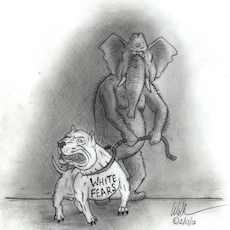
We originally published this article in December 2015. It seems the right time to again move this article front and center.
The GOP finds itself trapped in its southern strategy that has not only gone bad, but has left it exposed naked as Trumpism.
Starting in the 1960s, the Republican Party made a conscious effort to win votes in the South by appealing to racists. As Kevin Phillips, a political strategist for Nixon, explained in 1970: "The more Negroes who register as Democrats in the South, the sooner the Negrophobe whites will quit the Democrats and become Republicans. That's where the votes are. Without that prodding from the blacks, the whites will backslide into their old comfortable arrangement with the local Democrats."
The cynical strategy has, sadly, often paid off. However, by appealing to the lowest common denominator, Republicans have become the party of white identity politics. Donald Trump has taken that to the next level.
Donald Trump's racial rhetoric openly aknowledges the Party coalition Richard Nixon began to put together in 1968 - welcoming the segregationist white Southern Democrats into the former Party of Lincoln - and expanded by Ronald Reagan in 1980 - welcoming socially conservative white evangelicals into the Neo-Republican Party.
From post civil war reconstruction to the 1960's the south was solid Jim Crow Dixicrat Democrat. And then the Civil Rights Movement happened. President Johnson, a Democrat, pushed through the 1964 Civil Rights Act and the 1965 Voting Rights Act.
Because of that, Dixicrats began to flee the Democratic Party across the Southern confederate states to the Republican Party. This was the point in time when the Democratic and Republican parties began to assume their current identities as "liberal" and "conservative," respectively — and as we understand those terms today. Today, neither party stands for what it did from the mid-1800's through the mid-1900's, especially but not exclusively on racial issues.
The Democratic coalition included white supremacists (Dixicrats) through the mid-1960’s. By 1968, Republicans, led by Richard Nixon, saw the chance to take that segment of voters away from Democrats through a "Southern Strategy" of appealing to white racism against African Americans. And that, in fact, has been the Republican strategy consistently from the 1960s to Pres. Reagan's, Pres. G.H.W. Bush's, Pres. G.W. Bush's campaigns, and ultimately onto Donald Trump's 2016 campaign.
In the 1970s, white evangelical Christians were alarmed by rapid social changes, including legal abortion, LGBT rights, the legal availability of contraceptives for women, and equal employment rights for women. But above all, they were most alarmed by court ordered school desegregation busing, bringing black students into white schools. To the New Christian Right these changes constituted a crisis that threatened the white Christian American social order. In 1980, presidential candidate Ronald Reagan forged a partnership with the Christian Right to help him win election. Messaging to the Christian Right has held an equal place hand in hand with southern strategy messaging every since.
The southern strategy of coded bigoted messaging and religious right social issue messaging has worked to give Republicans solid control of local and state governments across the old southern confederate states. It has also worked to give Republicans control of most congressional districts across the old south, and therefore control of the U.S. House.
Republicans have gotten away with codified bigoted messaging because, as a practical matter, there was no political price to pay. Democrats have been reluctant to call out Republicans on their southern strategy, fearful that it might encourage even greater racial backlash. Indeed, the Democratic Party establishment developed their own Southern strategy, of sorts, electing centrists like Bill Clinton of Arkansas to the White House and a cadre of blue dog Democrats to Congress in the 1990's and early 2000's.
But the hope Democrats could woo back the old southern Dixicrats by moderating their liberalism was a fantasy. Conservatives upped the ante by moving the centrist middle further and further to the right with social causes and by ever more loudly encouraging Americans to hate their democratically elected government for catering to people of color, social deviants, immigrants, and everyone not part of the conservative religious right.